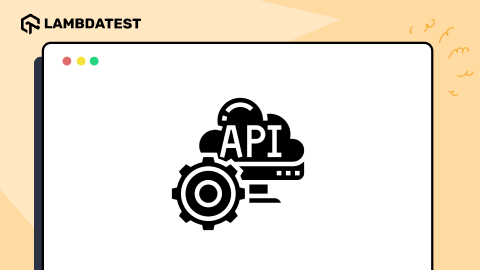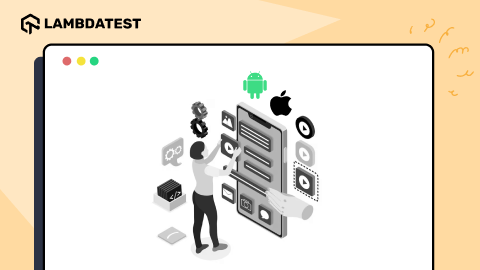Mobile App Testing Basics [With Real-Time Examples]
Rileena Sanyal
Posted On: January 7, 2022
![]() 34726 Views
34726 Views
![]() 29 Min Read
29 Min Read
This article is a part of our Content Hub. For more in-depth resources, check out our content hub on Mobile App Testing Tutorial.
It’s no wonder that the mobile app industry is booming, with over 3.2 billion smartphone users globally. Since the COVID-19 pandemic, mobile app downloads increased by 23.3% worldwide in 2020. According to Gartner, smartphones were sold 10.2% more globally only in the second quarter of 2021, despite the COVID-19 pandemic.
This is enough evidence to show that mobile apps and mobile app testing are especially significant in recent times. By 2023, mobile applications are expected to generate more than $935 billion in revenue. Therefore it’s important to have the right mobile app testing strategy to smoke the competition.

For an ultimate mobile app experience across different mobile devices and OS versions, it is crucial to perform end-to-end mobile app testing.
This article covers the basics of mobile app testing, types of mobile apps, and the frameworks and tools to develop and test them.
Let’s begin!
TABLE OF CONTENTS
What is Mobile App Testing?
Mobile app testing plays a critical role in ensuring applications work efficiently on all mobile devices and their OS versions. 2020 noted 218 billion mobile app downloads, thus reinstating the importance of deploying well-planned applications to draw users’ attention. Mobile application testing typically refers to checking functional and non-functional components of an app. In addition, highly skilled experts test its consistency, usability, performance, and compatibility across various platforms and devices.
A mobile application goes through several rounds of testing before it is released for end users. Corporates with big budgets also often launch a beta version of their apps to detect and eliminate bugs in the prototype. Several mobile app testing tools aid technical teams in carrying on the intricate testing procedures.
Read: Complete Guide On Testing Beta Apps
Android App Testing
Developed by Google and launched in 2008, Android is currently the most popular mobile operating system globally. As of September 2021, 72.44% of global smartphones run on Android. Hence, most mobile phone users across the world use Android, which makes it all the more important to test applications built to work on this platform.
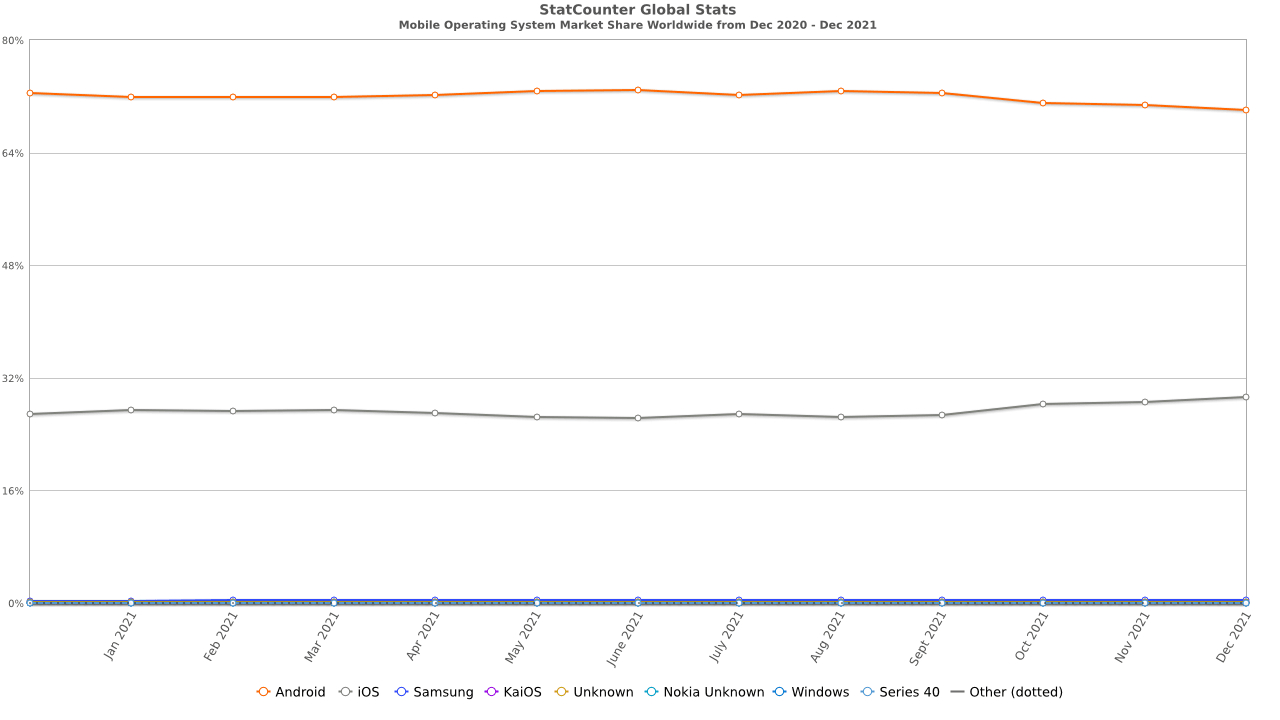
The following tests are typically performed on Android apps to test real-world scenarios.
- Functional tests: Tests if the app does what it was built to do.
- Performance tests: Tests if the app is fast and efficient in its job.
- Accessibility tests: Tests if the app works properly with accessibility attributes.
- Compatibility tests: Run Android device test to check if the app works correctly on all Android devices and API levels.
Get your free Andriod browser testing online started!!!
Also Read: Dec’21 Updates: Latest OS in Automation, Accessibility Testing, Custom Network Throttling & More!
iOS App Testing
Apple is one of the leading tech companies globally, quadrupling its growth in the last decade. In 2021, Apple earned a revenue of $365.82 billion, a whopping increase from its 2020’s $74.52 billion. In addition, the company has its own operating system, iOS, that powers all its mobile phones. From its popularity, it is not hard to guess how vast its app market must be to align with the growing needs of its users.
Since iOS has a limitation- it is available only on Apple devices, it is much easier to test iOS apps due to reduced device complexities.
Here are a few advantages of testing iOS apps:
- The sizes and specifications of Apple devices running on iOS are already fixed. Hence, QA testers find it much less complex to handle device testing. They can easily set up the basic premise for testing their apps.
- iOS is a closed operating system; hence it does not consume a magnanimous amount of resources like time and money for in-depth OS analysis.
- Because it has an entirely different operating system, Apple also has an array of mobile testing tools to facilitate the mobile testing of iOS apps.
- It is not easy for an application to be listed on the Apple app store. The company has stringent guidelines for it, and all iOS developers have to keep that in mind. Although this might seem like an inconvenience initially, it reduces the number of bug fixes and the constant need to keep upgrading and test the same app multiple times. Hence, once an app is out into the market, developers and testing teams can pretty much consider their job done for quite some time.
Here is a quick video tutorial on the Android and iOS app testing on real devices.
Types of Mobile Apps
In a world where different types of apps are being developed for multiple uses, understanding the app complexities in detail has become a critical requirement for success in the app world. Although there are many different types of apps on the market, we will cover Native, Hybrid, and Web Apps.
Native Apps
Native apps are applications built for one specific operating system or platform. Such apps are faster and deliver superior performance due to the ease of interaction between their interface and hardware and software. In addition, since native apps are developed to work on one platform, they can directly use the features made available by the architecture of the gadget.
While creating native apps for iOS or Android, developers use the most popular coding languages for the platform. Native apps for Apple’s iOS are built using Swift or Objective-C, while those for Google’s Android are developed using Java. Native applications like WhatsApp are built separately for all the available operating systems to ensure top-notch performance for all devices.
Advantages of Native Apps
- Best performance: Native apps are built to work on one specific platform. This makes them highly efficient and optimized to utilize the operating system’s benefits. Hence, native apps provide the best performance.
- Superb support system: Native apps receive immense support from the platform they are built for. The marketplace like Google Play Store and Apple App Store encourages such applications.
- Access to the entire feature-set of a device: Native apps have easy access to the whole platform’s feature-set, like a camera, GPS, and other hardware parts of the device.
- Single codebase: During the development phase, Native apps seem to have lesser bugs due to a single codebase.
- High consistency: Native apps are built with the help of native SDKs. Hence, such applications are highly consistent and have a robust user interface.
Disadvantages of Native Apps
- Expert developers are needed: Expert developers must build native apps as they require complete knowledge of the specific operating systems and the coding language.
- Expensive and time-consuming: Native apps are costly to build and are highly time-consuming since they are customized for the specific platform.
- The frequency of updates is high: Native apps need frequent updates propelled by the operating system they were built for.
Automate your mobile app testing on Apple or Android for free.
Examples of Native Apps
WhatsApp has maintained its position as the most popular messaging app, with 2 billion active users every month across the globe. Since its inception in 2009, the application has become a staple for personal and professional conversations without the constraints of time zones and national boundaries.
WhatsApp is a native app developed by Jan Koum and Brian Acton in 2009. In 2014, Meta acquired it (previously known as Facebook). Since then, WhatsApp has gone through many changes, each of which has made it more robust. WhatsApp is known for its efficient performance, high-quality video and voice calls, and easy media sharing options. All of its advantages are a direct result of its native nature that allowed the developers to explore the full potential of the respective operating systems.
Spotify
Another popular native app in the global market is Spotify. It is the multibillion-dollar music streaming application launched in 2006. The second quarter of 2021 noted 172 million subscribers to Spotify Premium. During the same time, in 2020, they had 144 million paid members.
Spotify uses modern technologies like Conventional Neural Network or CNN to evaluate music. Its algorithms are highly efficient in detecting a song’s volume, key, and tempo utilizing only the audio waveform. Spotify is further supported by the Google Cloud infrastructure that, in conjunction with its native features, helps it deliver high performance.
Web Apps
Web apps are web components that a user can use to achieve an outcome. Web applications are typically stored on remote servers and accessed through browsers on the user’s computer- desktop, cell phones, and tablets alike. The wide appeal of web apps stems from their high usability factor. Anyone can launch a website within a short time, with minimum resources, and still draw substantial global attention.
A good web application works fast and efficiently displays everything correctly. For example, 47% of viewers expect a web page to load in two seconds or less, thereby making efficiency a top priority for developers and mobile app testing teams.
Advantages of Web Apps
- Compatible across platforms: Web applications have high compatibility with most platforms across the technology ecosystem. They typically require a web browser only to load completely. This increases their scalability and makes them highly convenient for any firm in any industry.
- Easy to manage: Systems used to develop and test web applications need to be stored on the server only. End users are not involved in any of these processes, thus making web apps much simpler to maintain and manage.
- Easy to deploy: Web applications are the easiest to deploy. A user only needs the web address, a working browser, and an Internet connection to connect to such an app. In addition, web applications work even on limited bandwidth, thereby widening their scope of usage on a greater scale.
- Cost-effective: Web applications are not only affordable when compared to their native and hybrid counterparts, but they are also much cheaper to maintain. Their development and testing processes are hardly lengthy and do not entail hassles. Hence, web apps are cost-effective with great user satisfaction.
Disadvantages of Web Apps
- Performance: Web applications can often be large, decreasing their performance largely. They typically have 10 seconds or less to impress users, and unless a web app can load entirely within this time, the company might lose potential buyers because of reduced efficiency.
- Security: Security is a key point of concern with web applications. Studies have shown that hackers can use 9 out of 10 web apps to attack users. Further, 68% of web applications are threatened by breaches that steal sensitive data. Interestingly, 82% of vulnerabilities are present in the application’s code.
Read: 11 Key Challenges & Solutions Of Mobile App Testing
Examples of Web Apps
Google Docs
Google Docs is a real-time word processing web app that is free to use. It allows multiple users to write and edit as collaborators and automatically saves the document to Google Drive. The web application was built using Java and JavaScript, giving it a clean, easy-to-use interface.
Netflix
One of the most popular OTT platforms globally, Netflix serves 214 million subscribers in 190 countries worldwide. It is a web application supported by languages like Python, Kotlin, Java, and JavaScript. Netflix is known for delivering superb performance and maintaining a high customer satisfaction rate.
Hybrid Apps
Hybrid apps are developed using a combination of native and web app features. They have the shell of a native application over the underlying tech stack of their web-based counterparts. In addition, hybrid apps are typically built over a single code base for all platforms, facilitating high code reusability.
Hybrid apps are an attractive solution to a wider market because of their cost-effective, quicker development process. These apps are worldwidemanylightweight and have a user interface comparable to that of a native app. In addition, hybrid apps can be built using a web app technology stack that typically consists of HTML5, CSS, and JavaScript.
Advantages of Hybrid Apps
- Superb UI/UX: Hybrid apps have superb UI/UX, owing to the combination of web and native technologies used to develop these applications. Since HTML5, JavaScript and CSS are used extensively to build hybrid apps, the applications are lightweight, loading the content and graphics quickly and much faster.
- Greater appeal: Since hybrid apps are essentially web apps wrapped in the shell of their native counterparts, these can be deployed on any platform. This cross-platform functionality increases their appeal in the competitive market. Developers love hybrid apps too due to the high rate of code reusability where they do not have to write separate programs for Android, iOS, and other operating systems. Clients love hybrid apps because they are affordable to build and simple to deploy.
- Faster turnaround time: Building hybrid apps is faster than building native apps. This is because hybrid apps require a single codebase available in the existing web development toolkit that a company already has. Leveraging this helps to eliminate unnecessary jargon, making the process faster.
- Easy to maintain: It is easy to maintain hybrid apps because they can simply be updated in real-time (similar to the updation process of web pages) without the need for versioning.
- Offline support and availability: Hybrid apps have robust offline accessibility features that make their dependence on connectivity almost negligible. Hybrid apps can load content and graphics without relying on the Internet, thereby finding popularity in rural areas and areas with poor availability of network connections.
Disadvantages of Hybrid Apps
- Performance depends on the browser’s speed: Since hybrid apps utilize a lot of the web development toolkit, they rely heavily on their browser’s speed to operate well. Hence, if the browser is slow, the hybrid app will lag too.
- The hardware features of the platforms are not exploited: Hybrid apps are not as powerful as the native ones. Native applications utilize all the hardware features of the platform they are built for. However, since hybrid apps are not mainly made for one operating system, they cannot exploit platform-specific hardware attributes.
Examples of Hybrid Apps
Gmail
Gmail is the most widely used emailing platform and has 1.8 billion users around the globe. Launched by Google in 2004, Gmail has many variations- including a web app version. It has an elaborate user interface initially designed by Kevin Fox, who wanted the platform to feel like a one-page application.
One of Gmail’s advanced features is its spam filter and is driven by the community of users. The spam filter is an intelligent algorithm that learns from when a user marks an email as spam and identifies similar messages in other inboxes around the world. In 2020, 306.4 billion emails were exchanged globally every day.
The current annual revenue of Twitter is $3.72 billion. It is safe to say the social media app has created quite a stir with its presence alone. The platform is a stellar example of a hybrid app and highlights how powerful a well-made application of this nature can be. As of Q2 of 2021, Twitter had 206 million active users every day. This is enough to demonstrate the kind of traffic the app has to handle regularly without crashing down.
Twitter delivers excellent performance due to its hybrid nature. Hybrid applications do not depend on the network connection to completely load the app onto the device. This feature instantly introduces hybrid apps to a vast arena of users who lack good network connectivity. Moreover, since the loading does not depend on the Internet, it becomes superbly easy for the interface to manage traffic.
With so many apps released each year, it is critical to understand the difference between web, hybrid, and native apps.
Types of Mobile App Development Frameworks
A mobile app framework is a software development package that integrates tools and software, compilers, debugging tools, and programming interfaces. The developer then creates the source code for the application and the framework and uses various elements to develop the application for the different mobile devices.
Some mobile app development frameworks for both Android and iOS are listed below.
React Native
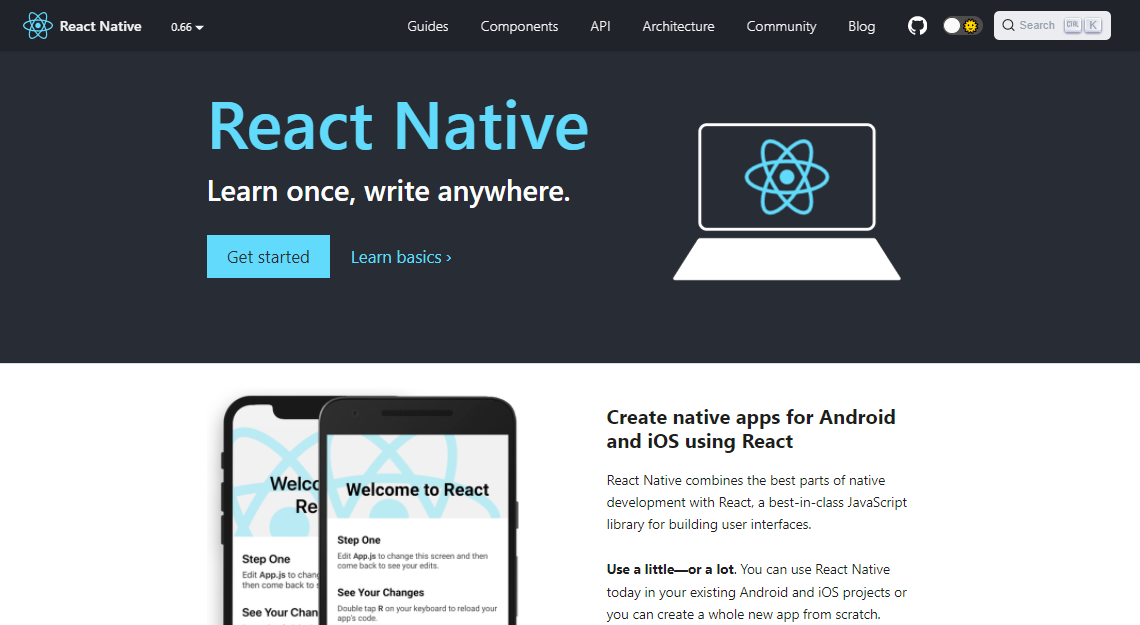
Developed by Facebook, React Native is one of the most widely used mobile app development frameworks. In addition, it is open-source and supports the creation of both iOS and Android apps, thus making it a first preference among the developer community.
Features
- React Native supports code reusability, which helps developers spend minimum time programming for an application. JavaScript, the underlying language of the framework, supports this attribute of React Native.
- React Native has a powerful user interface that allows coders to play around with the themes without continuously reloading the application. This is especially helpful from a business perspective, where logic can be used only to maintain the strategy from a user’s point of view. At the same time, the design is taken care of in the easiest possible way.
- React Native supports both live and hot reloading, thereby reducing the time between saving a change in the developed app and watching its incorporation on screen. This feature goes a long way to establish React Native’s underlying motto- stellar performance for developers.
Advantages
- Cost-effective: Owing to features like code reusability, lesser costs of maintenance, plenty of available libraries, React Native is a cost-effective solution for building mobile applications.
- Great community support: As an open-source framework used widely across the globe, React Native has a strong community of users who support other users around the clock.
- Intuitive architecture: React Native has a modular and intuitive architecture that supports quick app updates. Upgrading an application is also made simpler with this framework.
Disadvantages
- Complicated debugging: React Native has a complex debugging process, owing to the underlying languages like C/C++, Java, JavaScript that are inherently hard to debug. Also, since React Native goes back and forth between the native environment and JavaScript, developers need extensive knowledge of the former to understand what is going on.
- Too many updates: Powered and supported by a large community, React Native is often bombarded with updates. This can throw developers off guard since it takes time to adjust to changes made to the framework.
Flutter
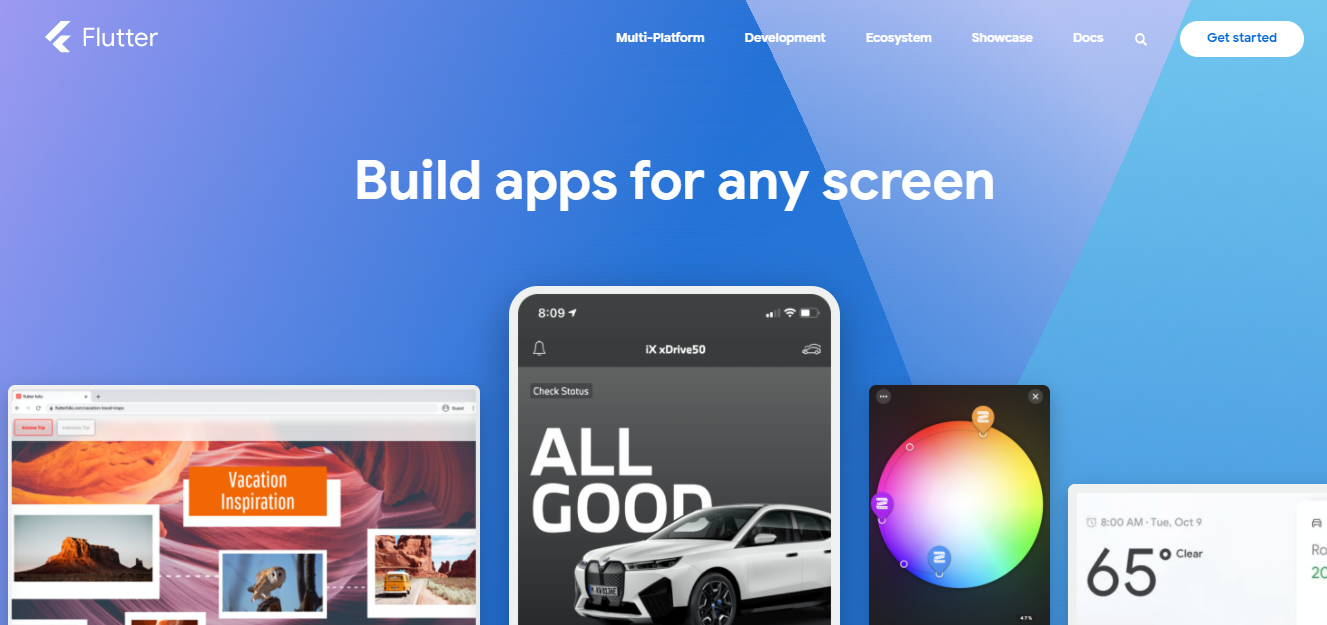
Flutter is a popular software development kit or SDK used globally for cross-platform mobile application development. Hence, it provides developers with the ability to build Android, iOS, and Windows apps using a single Codebase. Although it started simply as a startup, Google acquired it before planting its roots in the software community.
Features
- Flutter is an open-source project and is free to use across the globe. This is especially useful for fledgling developers who can acquire a lot of freedom in exploring all the qualities of Flutter and learn essential components of building mobile applications during the process.
- Flutter uses Dart, a programming language that is unique to its framework. Dart was developed by Google and can develop mobile and web applications. Dart was created to also facilitate building apps for desktops and servers. Its syntax is similar to C, but it follows an object-oriented approach.
- Apps built on Flutter have a native feel, even if they are compatible across all platforms. Hence, Flutter apps deliver a superb user experience, therefore inheriting a typical characteristic of native applications.
- Google added a feature that is now popularly called the ‘App Builder.’ One can think of it as a virtual lego building tool that developers can quickly exploit to create apps. This has proved to be an essential component in developing app prototypes.
Advantages
- Instant changes: Flutter allows its users to make instant changes. This comes in handy when developers need to make quick bug fixes to their applications. Without this particular attribute, it would have taken developers hours, if not days, to send out a bug fix.
- Superb UX: Applications made using Flutter deliver an effortless, smooth performance that makes for a powerful UX.
- Mobile app testing is simpler: Testing mobile apps and their quality assurance checks are more superficial using Flutter, thanks to its single codebase.
Disadvantages
- Web apps are not supported: Web apps cannot be built on Flutter. Moreover, the apps built on Flutter tend to be quite heavy, which users may not appreciate over a longer time.
- Coding can be tedious: Creating apps on Flutter can soon become a tedious process. This is because Flutter is relatively new to the game, and developers find themselves writing everything from scratch to make things work. Additionally, since Flutter uses Dart, a language that not many are aware of, developers have to learn this before using Flutter extensively.
Xamarin
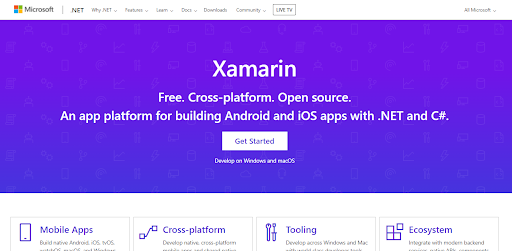
Xamarin, a Microsoft product, uses C# and .NET to build Android, iOS, Apple Watch, and Wear applications. Xamarin is famous for being a time and cost-effective solution for cross-platform mobile app development.
Features
- Applications built on Xamarin use the .NET base class library or BCL. This is essentially an extensive collection of classes loaded with features such as Serialization, XML, String, IO, Database, support for Networking, and many more. It also allows pre-existing C# codes to be used in an application, extending its functionality limit beyond the BCL.
- Xamarin utilizes a modern IDE, namely Visual Studio, one of the most popular IDEs around the globe. VS is famous for its auto-code completion features. But it also provides attributes like project and solution management, libraries, source control, and other resources that make it truly powerful.
- Xamarin is great for cross-platform app development, supporting the three major platforms- Android, iOS, and Windows. In addition, around 90% of the code written in Xamarin can be reused, thus saving time and cost of development.
- Xamarin.Essentials add to the usefulness of the framework. It provides a unified API for resource sharing facilities across all the supported platforms- Android, iOS, and Windows.
Advantages
- Xamarin Test Cloud: Xamarin Test Cloud is an excellent platform for mobile app testing. With Xamarin’s cloud, developers can test a single application on multiple devices, point out the issues, and fix them in a jiffy. In addition, Xamarin Test Cloud offers superb flexibility that proves to be a valuable addition to developer toolkits.
- Powerful UI features: Developers have many UI components like themes, graphs, charts, and cloud services to choose from. This enhances the user experience in a single jump, thus becoming a popular choice among coders.
- Great for cross-platform usage: Due to 90% code reuse, Xamarin is often an excellent choice for developing cross-platform applications. This shared code logic helps developers build an app once and reuse it for multiple platforms.
Disadvantages
- Lack of support: Xamarin lacks a community to back it up. Unlike Android, iOS and .NET have robust communities with a wealth of knowledge. Compared to that, Xamarin is still growing and falls short of resources for developers to look into.
- App overhead: Xamarin creates a massive overhead that increases the time it takes for users to download and store apps on their devices. This can critically affect user satisfaction.
Frameworks to Test Mobile Apps
Below are the popular frameworks for Android automation testing and iOS automation testing of mobile applications.
Appium
Appium is another mobile app automation testing tool to automate web, native, and hybrid mobile app testing on all mobile and desktop platforms. Apps do not need recompilation or modification and do not need to adhere to any specific languages for Appium to automate their tests. Also open-source like Selenium, Appium proves to be a powerful tool for developers to play around with. Run your free mobile tests on Appium grid.
Looking to automate mobile apps on real devices, check out our video below –
Ranorex
A software development company, Ranorex GmbH, provides this framework. It is a GUI test automation platform that facilitates testing all kinds of mobile applications. Ranorex Studio supports languages such as VB.NET and C#.
Apache JMeter
Categorized under the Apache project, Apache JMeter is used heavily as a load testing tool. In addition, it is utilized to measure and analyze various services, especially web applications for mobile. But JMeter can also be used as a unit testing tool and has its architecture based on plugins.
To know more about app testing frameworks, you can refer to our blog on the best mobile app testing frameworks for Android and iOS apps.
Key types of Mobile App Testing
Mobile app testing helps identify flaws in mobile apps and refine them for the intended audience. Therefore, it is critical to consider the various key types of app testing to understand the multiple perspectives for evaluating an app’s potential performance.
Below are the listed key types of Mobile App Testing.
Functional testing
Functional testing of mobile applications checks whether the app is functioning correctly. This kind of test ensures the components are behaving as they should- they are responsive, true to their purpose, meet the required specifications, and the flow of the app is being maintained.
Example: Suppose an e-commerce app needs to be tested for functionality. Here, a product can be added to the cart to check the ‘Add to cart’ feature is working fine. The customer can then proceed to checkout to ensure that the payment features are working.
Usability testing
Usability testing brings the user’s experience to the forefront. It checks how user-friendly a mobile app is if it requires bug fixes, how intuitive its interface is, and how easy it is to navigate through the application. Usability testing provides a holistic report of a customer’s feedback while using the application.
Example: A mobile app usability testing example would be creating a survey of questions that an end-user is asked to answer after using an app for a while. This can provide great insight into what needs to be further modified.
Compatibility testing
Compatibility testing is a non-functional technique that checks if an application is ready to deliver great performance on multiple devices and operating systems, in specific network conditions, and with various hardware specifications.
Example: An app like Amazon Prime Video can be tested to check if it is running on all devices- mobiles, desktops, TVs, tablets, etc., of all specifications.
Load and Performance testing
Performance and load testing ensure an application is not performing poorly under specific workloads. In addition, these tests provide the device resource consumption, like battery, time, and memory are not being expended to a great extent.
Load and performance testing also checks for network delays, the performance of servers, and the format in which data is being sent and received at the backend. Applications should also have an inherent backup and recovery system for an unprecedented data loss.
Example: A typical example of load and performance testing is running tests on an e-commerce app before a big sale day. Due to heavy traffic, there are high chances of the application crashing mid-way. Performance and load testing can stop that from happening.
Security testing
Security is one of the deciding factors behind whether a person will download and use the app or not. Unless data privacy, authenticity, and integrity are ensured, users will never feel comfortable using an app, especially since most applications ask permission to access a user’s private information. Hence, security testing is imperative to ensure users’ data is safe and well protected.
Example: An SSL protocol is used by website or web app owners and developers to authenticate communication and data exchange between the client and the server.
Installation testing
Installation testing checks if the installation and uninstallation procedures of an application are smooth and without hassles. This kind of testing also ensures the updates to an app are without errors and undisturbed.
Example: While installation testing, network connectivity can be checked by changing the device connection from WiFi to 4G cellular data. Ideally, the installation should not be interrupted, and the procedure should continue irrespective of this alteration.
Localization testing
Localizing testing ensures an application is ready to be used in various local markets. From a change in currencies to a change in cultures, an app should ideally be able to handle all that, especially if it is targeting a wide demography of audiences around the globe.
Users expect their applications to run smoothly and represent them while solving their particular problems with unique solutions. Therefore, consumers tend to lose interest if an app is not aligned with these clauses.
Example: Running tests to ensure an e-commerce site in the US, the UK, and India has a currency changing feature for the appropriate location.
Device testing
Device testing is an essential part of the mobile app testing process. Many applications’ functionalities depend highly on a mobile’s internal hardware specifications and operating system. Device testing ensures an app is ready to run on a spectrum of devices with any combination of specifications.
For example, since building physical infrastructure to support this is quite cumbersome, the LambdaTest Mobile app testing platform can come in handy here. It provides a wide range of 3000+ devices and OS combinations on the cloud that testing teams can exploit to ensure their app is running everywhere and under all conditions.
Types of Mobile Testing (Manual and Automated)
Mobile testing can be performed using one of two methods:
- Manual mobile application testing
- Automated mobile application testing
Manual Mobile App Testing
Testing mobile apps manually rely solely on a human to test an application from scratch until the end. This means the quality assurance testers cannot use automation tools, scripts, or other resources to carry on these tests. To begin with, this sounds ghastly, especially when one imagines the number of tests that must be run to ensure one application will perform well in the real world. Hence, one might be tempted to do away with manual testing completely.
However, discarding manual tests is unwarranted as the end-users are still humans, and automation, no matter how beneficial, time, and cost-effective, might not be prepared to guarantee the way an app feels to a real, breathing consumer of flesh and blood. Hence, manual testing is needed and still performed reasonably, just as a final nudge of reassurance for the testing team.
Automated Mobile App Testing
Automated mobile testing eg. android automation testing is the need of the hour when it comes to running multiple application tests. Here, testing teams use mobile app testing tools for automation and testing clouds to test the functionality and viability of an app in multiple conditions. Automated tests are typically used where a number of tests need to be run simultaneously. However, developers and testers still have to partially rely on human supervision in complex cases.
Automated mobile app testing is fast, efficient, and affordable. It does not require setting up a huge infrastructure of physical devices as would have been necessary for manual mobile app testing. In addition, almost all tests can be performed using the cloud, which leading companies like LambdaTest provide.
Testing Your Mobile Apps Using LambdaTest
LambdaTest enables you to test mobile apps on real devices, simulators, and Android emulators online. As a result, you run the tests and detect bugs across multiple Android and iOS devices early in the development cycle. This enables you to replace your expensive in-house device labs with a mobile testing cloud for all manual and automated app testing requirements. Have a look at this seminar brief that talks about end to end mobile testing. Before you kick start Mobile app testing, refer to this ultimate mobile app testing checklist for carrying out effective mobile device cloud testing.
Test your Locally Hosted apps Using the LambdaTest Tunnel, you can ensure the sanctity of your locally hosted or privately hosted apps by running test on Vivo emulators. No complicated set up, Underpass will do it for you. Start your free test now!
Read More: Getting Started With Mobile App Testing Using Emulators And Simulators
 Note
NoteKick start mobile app testing journey for free. Try LambdaTest Today!
You can also test apps on LambdaTest real device cloud to test real-world scenarios of your app. The real device cloud for Mobile app testing allows users to access real devices and test their apps on a variety of real Android and iOS devices. Using real device cloud testing, you can test your native apps for functionality, compatibility, and reliability. For real devices you can configure your automation frameworks tests through our real device capabilities generator.
Read More: 15 Most Important Mobile App Testing Scenarios
Here is a quick rundown of the features offered by LambdaTest Mobile App Testing Platform.
Summing Up!
Mobile app testing is an important part of a mobile application’s life cycle. While Android apps seem to have the greatest hold in the global app market, Apple is much more classified and sophisticated while dealing with applications created for iOS. Mobile app development frameworks and tools help developers and testers build state-of-the-art applications for Android, iOS, and Windows operating systems before sending them to various app stores.
In this article, we explored the basics of mobile application testing to understand the topic as a whole and in parts with respect to testing applications for Android and iOS. We also discussed types of apps, mobile development frameworks and tools, and how LambdaTest – a cloud test execution platform caters to your Mobile testing needs.
Also, read our short guide on what is a mobile application?
Frequently Asked Questions (FAQs)
How can I test my Mobile Apps?
You can test Mobile applications on various Android and iOS devices either using real devices or emulators and simulators. Testing on real devices allows users to test apps in real-world scenarios. While testing on emulators or simulators can be beneficial in the early stages of development, they are not reliable enough to ensure the efficacy of applications in real-world user environments.
What are the type of Mobile testing?
Shown below are the types of Mobile testing:
- Functional Testing
- Performance Testing
- Usability Testing
- Localization Testing
- Interruption Testing
- Speed Testing
- Memory Leak Testing
- Security Testing
Got Questions? Drop them on LambdaTest Community. Visit now












